How To Make Cycling Safe for Half a Million People in Delaware
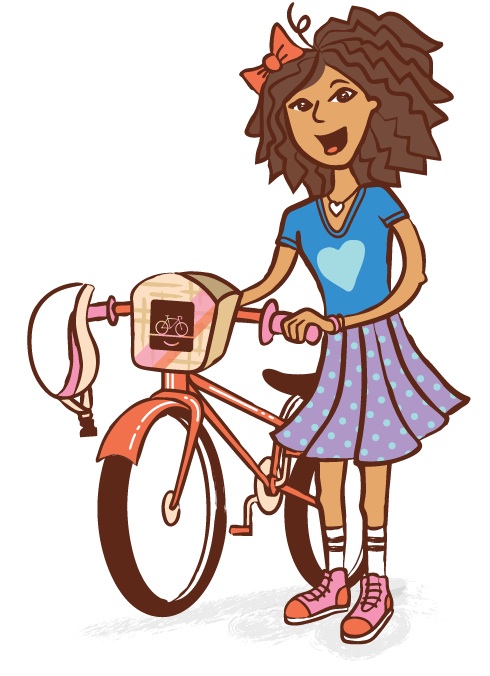
5 years ago, Bike Delaware went through a long and arduous strategic planning process. One of the most important results of all that effort was our organizational “vision“.
Bike Delaware has both a “mission” and a “vision”. Both are critical. They are our compass, our lodestar, our flashlight shining into the future. They keep us on track and focused.
What is the difference between the two? I think of them as very similar but a “mission” is more abstract and general while a “vision” is more specific. A good analogy is: the mission is the journey. The vision is the destination.
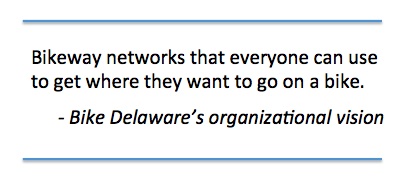 Bike Delaware’s mission – the reason the organization exists – is to make cycling a safe, convenient and fun transportation option in Delaware. That’s the journey we are on. But what direction are we going? That’s where our vision comes in. Bike Delaware’s vision is bikeway networks – connected routes that are designed for cycling – that everyone can use.
Bike Delaware’s mission – the reason the organization exists – is to make cycling a safe, convenient and fun transportation option in Delaware. That’s the journey we are on. But what direction are we going? That’s where our vision comes in. Bike Delaware’s vision is bikeway networks – connected routes that are designed for cycling – that everyone can use.
In order to make this vision a reality, we first need the language and tools to describe what a bikeway network is and who would be comfortable using it to get around.
That’s why Bike Delaware is incredibly excited that DelDOT has hired Civil Engineering Professor Peter Furth (Northeastern University) as a consultant to help implement a new tool to help plan effective, safe, and well connected bikeway networks. Dr. Furth’s method is called “Level of Traffic Stress Analysis”.
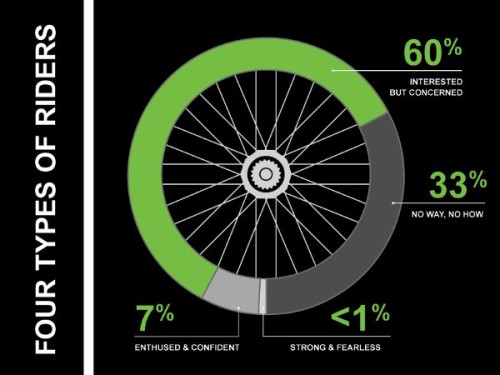
Different people have different tolerances for traffic stress. The largest segment of the population – about 60%, or around half a million people in Delaware – has a relatively low tolerance. (See Who Is a “Cyclist”?)
The basic idea behind Level of Traffic Stress analysis is that everyone has a particular tolerance for “traffic stress” – the physical and mental stress induced by automotive traffic. Think of it as a comfort zone for cycling around town.
If a particular trip contains a segment which is out of a cyclist’s comfort zone, he or she will find a less stressful detour. But if no reasonable low-stress detour exists, cyclists may choose to try to manage that trip segment by dismounting and walking, or riding on a sidewalk or even on grass. Most likely (if the option exists), he or she will simply not cycle at all and instead accomplish the trip via another mode.
Whenever a cyclist is unable to get from point A to point B within their comfort zone and without unreasonable detour, that is a failure of infrastructure. Or, to make the same point in a more positive and optimistic way, that is an opportunity for improvement.
In Level of Traffic Stress (LTS) analysis, roads, streets and pathways are rated on a simple scale from 1 to 4. The LTS is determined by a few simple, intuitive inputs that affect how people riding bikes typically interact with the street. Are there bike facilities present? If so, what kind? How wide are they? Do cyclists have to share the roadway with cars? What’s the speed limit? Are intersection crossings safe? These factors are then used to determine the LTS designations for route segments and intersections.
To make cycling comfortable for the widest possible population, most cycling trips from beginning to end should be possible using low-stress streets or pathways (i.e.”LTS 1″ or “LTS 2” routes). The collection of such existing routes is the low-stress bikeway network. Using LTS analysis, we can determine the size of the low-stress bikeway network, where it goes, estimate how many people have access to it, how many of their daily trips are feasible under low stress conditions and – most importantly – how the addition of new infrastructure would likely affect these numbers.
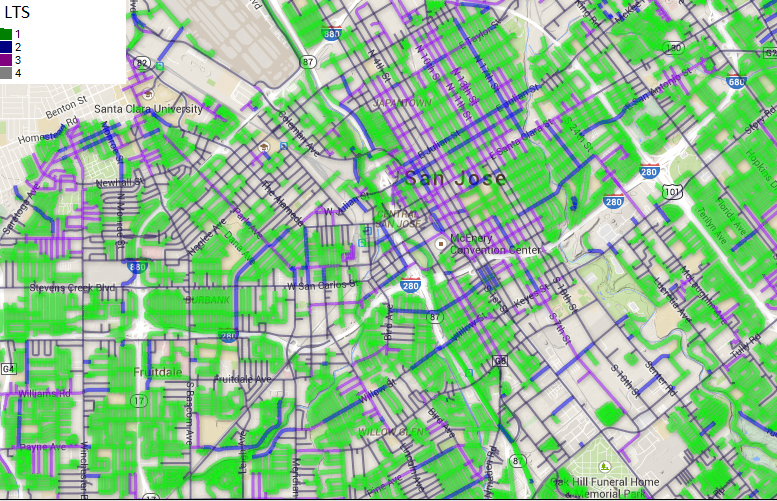
This map shows the bicycle network accessible to the Strong and Fearless type in San Jose, California – essentially anything they’re crazy enough to ride on short of express-ways.
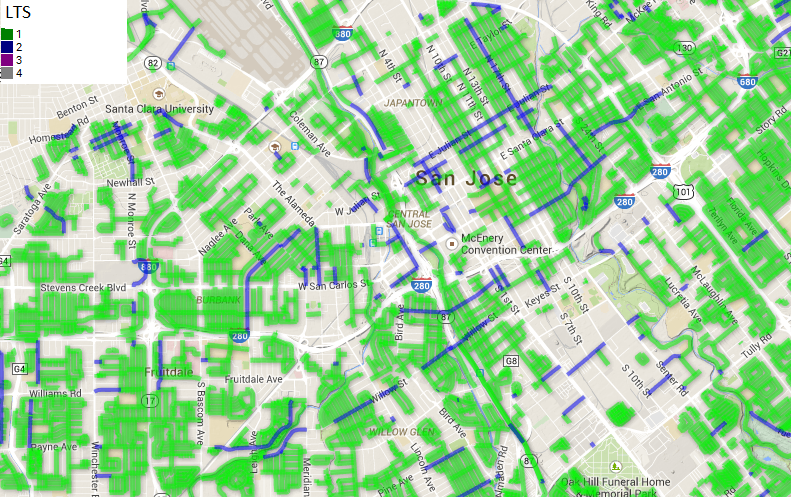
And this map shows the Low-Stress Bicycle Network – the network of streets and paths at LTS 1 and LTS 2 conditions. Clusters of low-stress streets are disconnected from one another by high-stress segments, creating “low-stress islands”. This fragmentation of the bikeway network prevents safe, comfortable travel across the city. These maps present an incredibly useful visual to assist in planning new infrastructure to bridge these gaps and make a larger area accessible at low-stress conditions.
In Delaware’s recent Bicycle Friendly Report Card, the League of American Bicyclists’ #1 recommendation was to “Develop a capacity to analyze bicycle travel in terms of the percentage of trips that can be made under low traffic stress conditions”. That’s exactly what LTS Analysis offers. When this tool is integrated into future planning efforts, DelDOT will gain profound new insight into how new pathway and roadway projects affect the area’s bikeability and relation to the existing bikeway network. And Bike Delaware will gain a needed quantitative tool that we can rely on to make our vision of bikeway networks – that everyone can use to get where we want to go – a reality.
Special thanks to the University of Delaware Office of Service Learning for supporting this project. Maps of San Jose were generated from interactive maps by Axum Design and Engineering.

Paul Moser is a Bicycle Network Planning Intern at Bike Delaware. He studies civil engineering at the University of Delaware and works with DelDOT as a consultant on Level of Traffic Stress analysis.

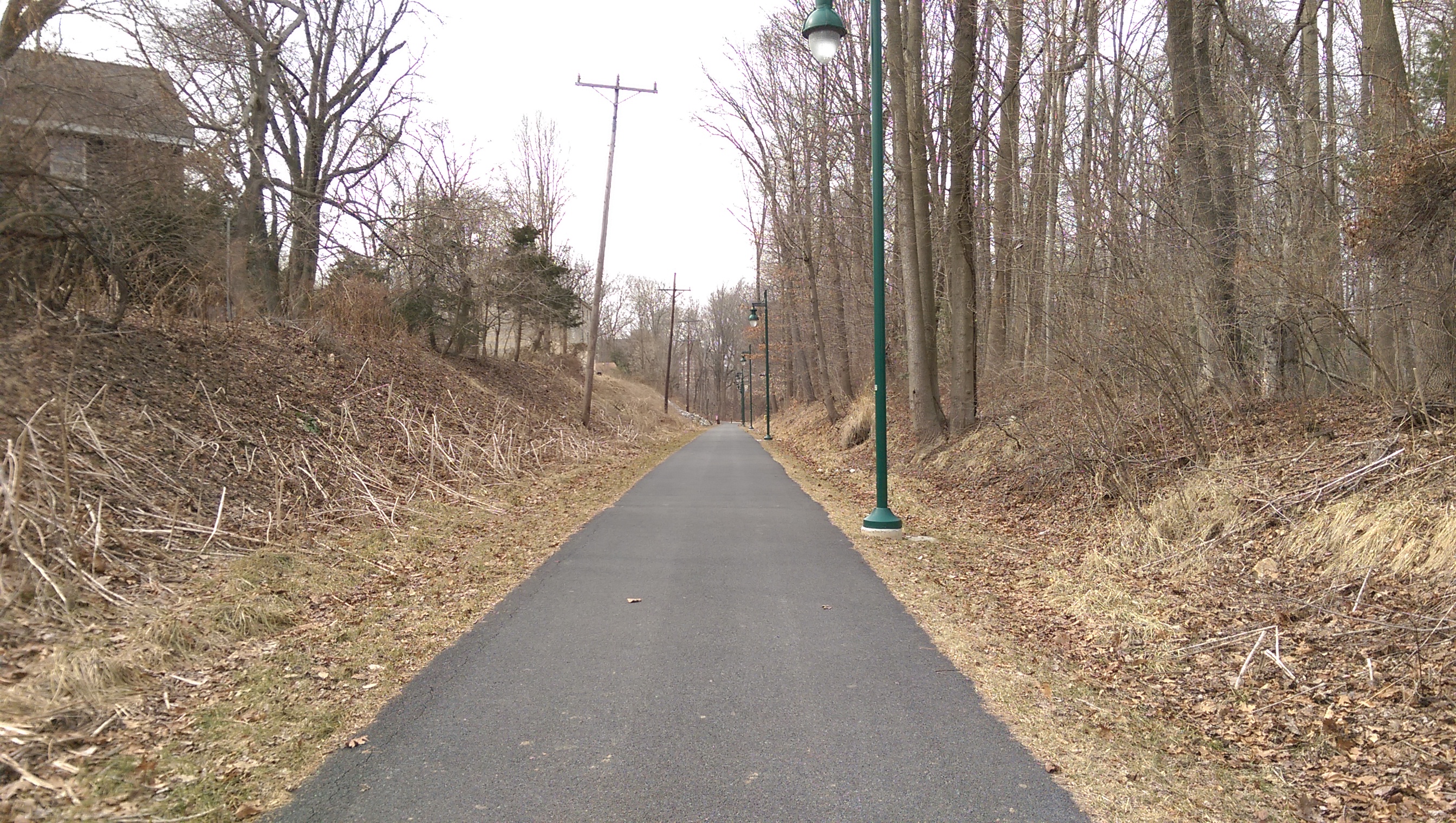
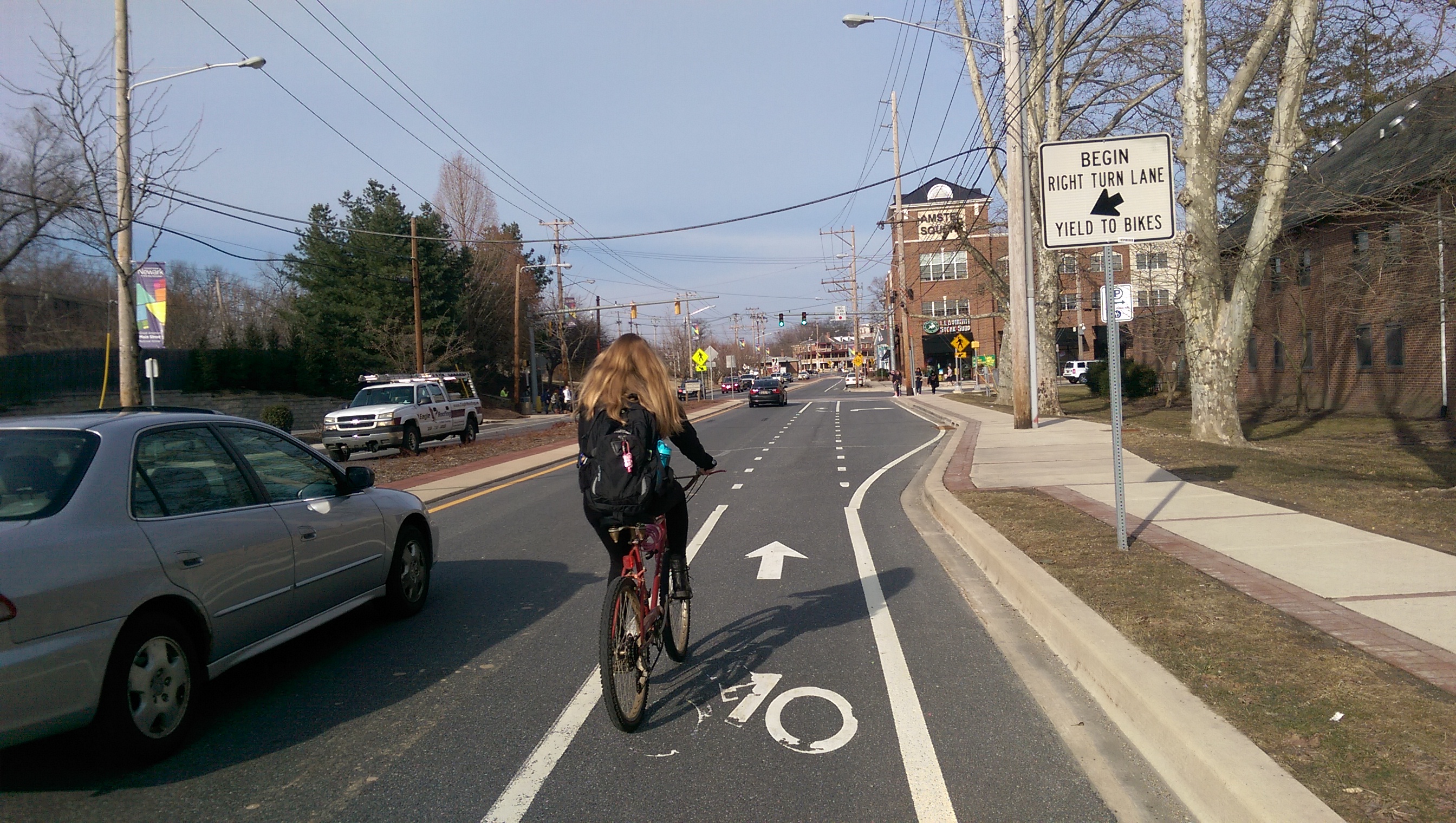
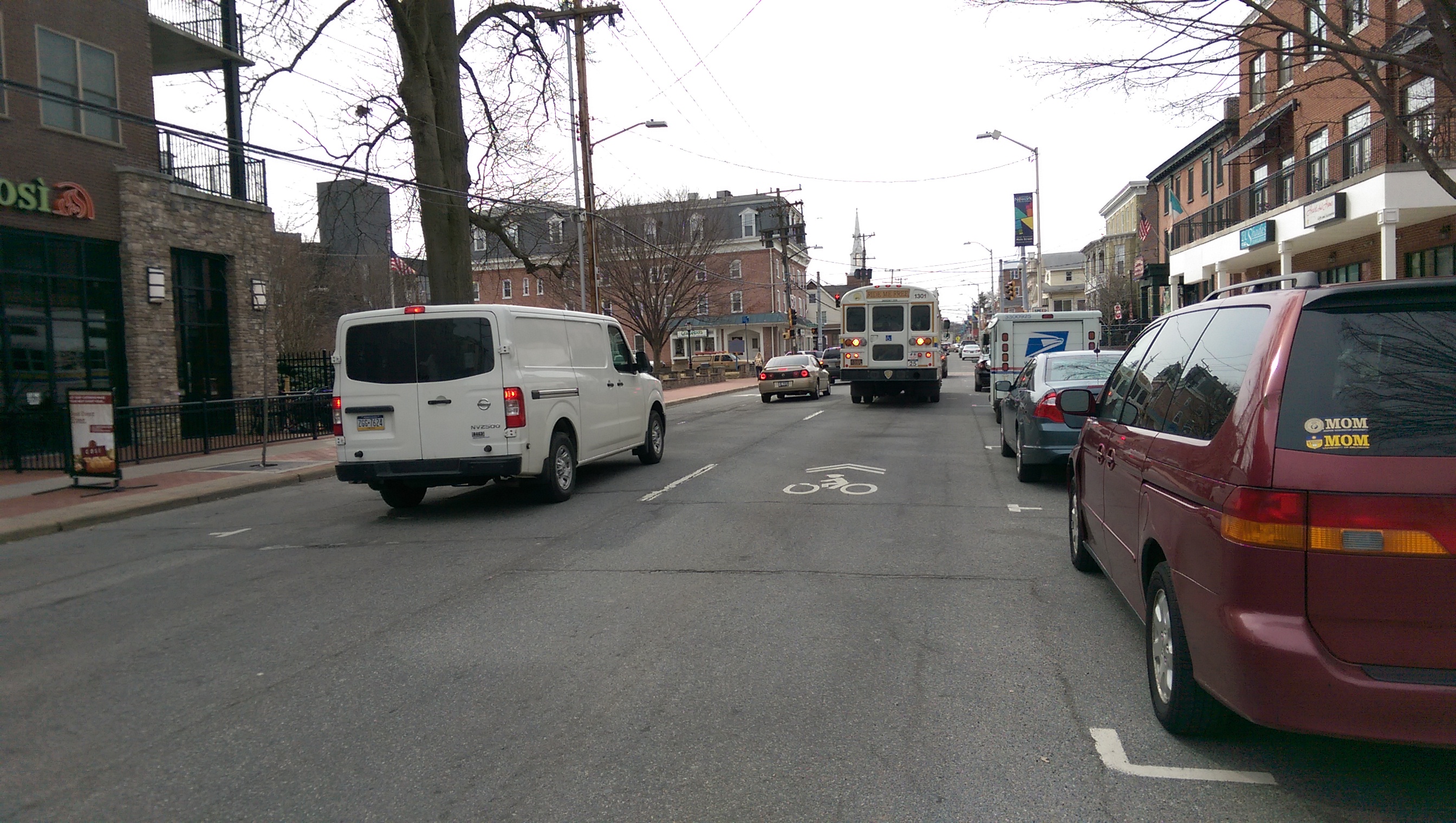
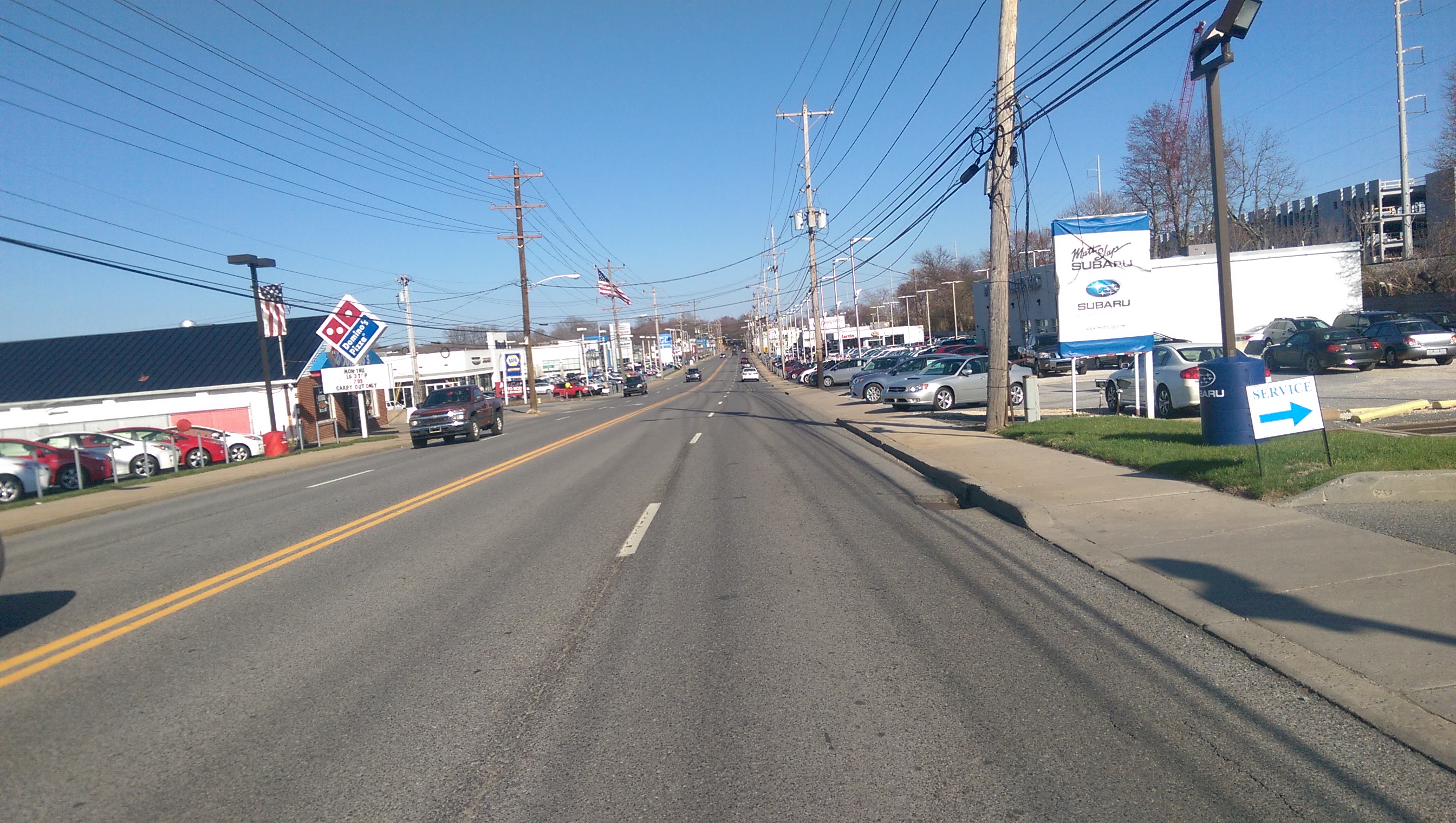


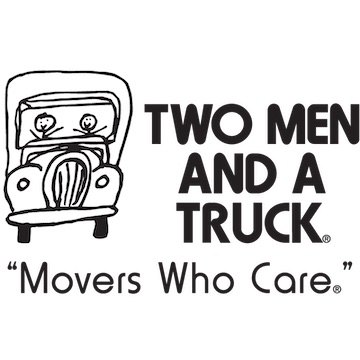

6 Responses
Check out Chapel Street, Newark, where the corporate Burger king and Td bank have new left hand turn lane entrances ~that should be safe entrances off of Delaware Ave, the one way street. Those corporate turn lanes have moved car traffic to the curb and eliminated the bike lane, causing many accidents where cars turn into the right of way path of bikes. It happens all the time and should be the first rerouting of a State road in Newark to re-establish a bicycle network over the supposed interest of corporate gods!
Wow, I guess I’m “Strong and Fearless” I used to ride that to get to work every day.
I have a great deal of respect for Professor Furth and believe that his articulation of the term “Level of Traffic Stress” (something I long understood but just never articulated) is crucial for the advancement of cycling. That said, his criteria is missing something incredibly important that in my opinion almost fatally flaws his system: traffic volume. That his system would call all two-lane rural roads, with a 35mph+ speed limit LTS4 is laughable. Even in densely populated NJ, I could take you and Prof. Furth on roads with 45mph speed limits that one could lay in the road, take a nap, and not get hit by a car. If you look at his original paper, the system he came up with that does not use traffic volume because he didn’t have that information available to him. Granted it is the hardest info to get to evaluate a road but still critical to properly appropriate funding to roadway projects to make them more bicycle friendly. Blindly using his system (and engineering firms without experienced cyclists already are), even these sleepy roads that I talk about would need sidepaths and that is just absurd!
The criteria for LTS designations are still being refined (contrary to what the link in the article may convey). A recent update DOES factor traffic volumes into the criteria for mixed-traffic LTS designations. Traffic volumes will probably be a significant factor in evaluating the LTS of shoulderless rural roads seen more abundantly downstate.
Not that I know of.
If you want to see a high-stress bike area, check out the renovated intersection in front of acme on Elkton road. They put up these stupid concrete things which leave about 4 inches of space between the barrier and the lane. You might say “go ahead and take the lane” but people do 50+ there.
The renovated intersection is a cyclist deathtrap. Swear to god whoever designed that is trying to kill cyclists.